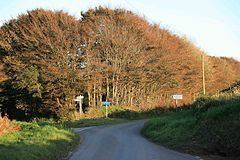Civil parish St Pinnock Sovereign state United Kingdom | ||
 | ||
Population 676 United Kingdom Census 2011 including Connonu | ||
History of St Pinnock
St Pinnock (Cornish: Sen Pynnek) is a hamlet and civil parish in southeast Cornwall, England, United Kingdom. The parish of St Pinnock has always been in the Liskeard Registration District, containing 421 inhabitants. It is situated a little to the south of the great Plymouth and Falmouth road, and comprises 3487 acres, of which 112 are common or waste; the soil generally is best adapted to the growth of corn. There is a stream called Herod's Foot that runs through the parish; and there is a lead and silver mine of the same name, but not at present worked. Stone of excellent quality is also quarried for flooring and building purposes. To the north, the parish is bordered by St Cleer and St Neot parishes, to the east by Dobwalls and Trewidland parish, to the south by Lanreath and Duloe parishes and to the west by Broadoak parish. The A390 runs through the north of the Parish.
Contents
- History of St Pinnock
- Population Structure of St Pinnock
- Church of St Pynnochus
- St Pinnock Viaduct
- References
St Pinnock hamlet is just over a mile (2 km) south of Dobwalls and 3 miles (5 km) south-west of Liskeard. Other settlements in the parish include East Taphouse, and Penfrane. The parish church is dedicated to St Pinnock and is located at |OS Grid Ref SX200630.
In the 1870s, St Pinnock was described as:
PINNOCK (St.), a parish in Liskeard district, Cornwall; adjacent to the Cornwall railway, 3¼ miles W by S of Liskeard r. station; and 1¼ S of Doublebois r. station. Post-town, Liskeard. Acres, 3, 487. Real property, £2, 464; of which £350 are in mines. Pop., 571. Houses, 104. The property is subdivided. The living is a rectory in the diocese of Exeter. Value, £285.* Patrons, A. Coryton, Esq., the Rev. E. J. Treffry, and the Rev. J. Rawlings. The church is very ancient, and has a tower. There are chapels for Bible Christians and CalviPopulation Structurenistic Methodists, and a free school.
Population Structure of St Pinnock
The parish is in the Liskeard Registration District and the population at the 2001 census was 621; at the 2011 census it had increased to 673. According to the 2011 Census there were 315 males and 361 females living in the parish.
Church of St Pynnochus
The small parish Church of St Pynnochus, St. Pinnock, is a listed place of worship with a heritage category grade I. The St Pinnock Parish Church lies on the edge of the hamlet of St Pinnock, where there are two Methodists Chapels: Canon Chapel and Trevelmond Chapel, located within the parish. Other settlements in the parish include East Taphouse and Trevelmond. The parish has a Church of England Primary School and a Community Hall, both at East Taphouse.
The Parish Church is described as a:
Small parish church. Norman cruciform origins with C15 north aisle and nave rebuilds, the tower of C14, C16 south porch. Coursed rubble with granite dressings. Cornish slated roofs with some slates slipped. Damp tower with much vegetation growth and problem downpipe on the north side
St Pinnock Viaduct
The Cornwall Railway company constructed a railway line between Plymouth and Truro, England, opening in 1859, and extended it to Falmouth in 1863. The 70 miles (110 km) of railway crossed 45 rivers and deep valleys. Of these 43 were spanned by viaducts of various types built partly or entirely from timber. One of the viaducts, the St Pinnock railway Viaduct, was built in 1854-5 by Isambard Kingdom Brunel, and was heightened in 1882. It consists of 7 piers roughly dressed, coursed slatestone from Westwood quarry. It stands at approximately 60 foot with each pier consisting of 8 buttresses with weatherings rising to form 5 stages with pointed openings piercing the 4 upper stages. Batter of about 1 in 100. In 1882 the piers were heightened with a slightly cruder, tapering, sixth stage and iron girders were used to replace Brunel's timber trestles. The 2 track railroad of 1882 and later carried on rivetted plate steel girders with steel guardrails and refuges to the north side. It is considered the tallest viaduct on the railway in Cornwall, 633 feet in length and 151 feet in height. The line was singled over this viaduct on 24 May 1964 to reduce the load on the structure. Beneath the viaduct is the Trago Mills out-of-town shopping complex.
